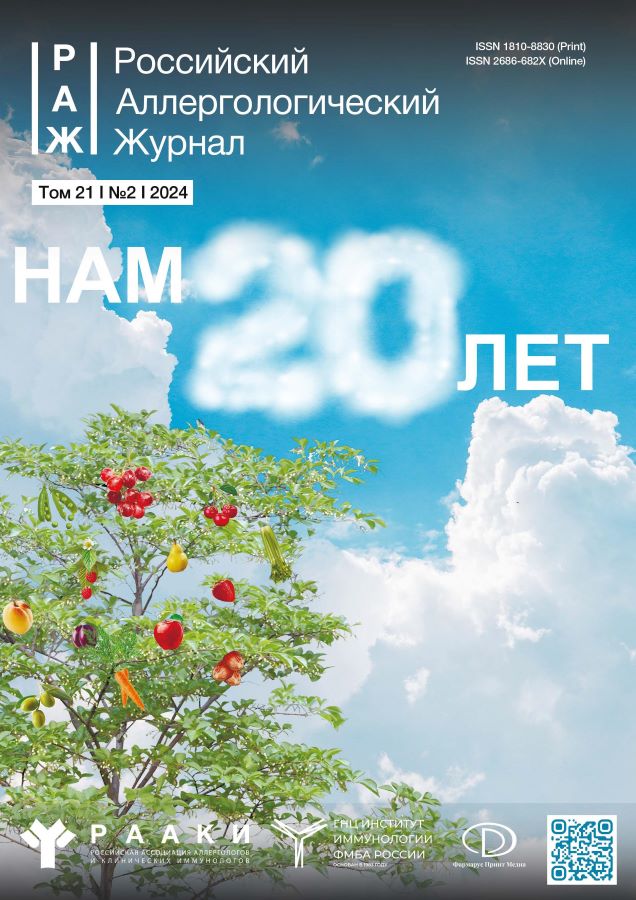Experience of lanadelumab usage for long-term prophylaxis of attacks in hereditary angioedema in patients of the Moscow region
- Authors: Proskurina E.V.1, Morozova N.V.1, Kokushkin K.A.2
-
Affiliations:
- Moscow Regional Research and Clinical Institute
- Scientific and Practical Center for Clinical and Economic Analysis of the Ministry of Health of the Moscow Region
- Issue: Vol 21, No 2 (2024)
- Pages: 254-264
- Section: Технический отчёт
- Submitted: 23.01.2024
- Accepted: 14.05.2024
- Published: 16.06.2024
- URL: https://rusalljournal.ru/raj/article/view/16913
- DOI: https://doi.org/10.36691/RJA16913
- ID: 16913
Cite item
Abstract
BACKGROUND: Hereditary angioedema is a rare disease with high frequency for orphan diseases. The autosomal dominant type of inheritance leads to a significant number of affected patients in families. Angioedema attacks significantly impair the quality of life. hereditary angioedema causes life-threatening conditions which depend on edema’s localization.
AIM: To evaluate the efficacy and safety of lanadelumab for long-term prophylaxis in hereditary angioedema in routine practice.
MATERIALS AND METHODS: 16 patients with hereditary angioedema were enrolled in the observational single-center study. The data were researched: sex, patients age, age of symptoms onset, efficacy of previous methods of therapy, type of hereditary angioedema, genetics of the disease, contraindications for other prophylaxis methods. The efficacy of therapy was evaluated according to the duration of the course, the frequency of administration, the number of attacks of edema during the period of observation, and the improvement of the quality of life according to the AAS28 scale. Safety of use was evaluated by the presence of adverse events during the investigation.
RESULTS: The long-term prophylaxis with lanadelumab was effectively and safety for all of 16 patients. Single attacks during of therapy were provoked by the influence of significant triggers. Life-threatening attacks were not registered. The frequency of lanadelumab injections was reduced after 12 months of usage for 50% of patients. The improvement of the quality of life (from 6 to 38 according to AAS28 scale) was confirmed for all patients. Adverse events weren’t registered during the period of treatment.
CONCLUSION: The long-term prophylaxis of edema in hereditary angioedema with lanadelumab usage was approved as efficiently and safety.
Keywords
Full Text
About the authors
Elena V. Proskurina
Moscow Regional Research and Clinical Institute
Author for correspondence.
Email: alberus17@gmail.com
ORCID iD: 0009-0002-4865-433X
SPIN-code: 8105-7529
Россия, Moscow
Natalia V. Morozova
Moscow Regional Research and Clinical Institute
Email: natalya_morozova_63@bk.ru
ORCID iD: 0009-0004-5617-2335
MD
Россия, MoscowKonstantin A. Kokushkin
Scientific and Practical Center for Clinical and Economic Analysis of the Ministry of Health of the Moscow Region
Email: Kokushkinka@gmail.com
ORCID iD: 0000-0002-6758-2389
SPIN-code: 7074-8300
MD
Россия, MoscowReferences
- Maurer M, Magerl M, Ansotegui I, et al. The international WAO/EAACI guideline for the management of hereditary angioedema-The 2017 revision and update. Allergy. 2018;73(8):1575–1596. doi: 10.1111/all.13384
- Cicardi M, Aberer W, Banerji A, et al.; HAWK under the patronage of EAACI (European Academy of Allergy and Clinical Immunology). Classification, diagnosis, and approach to treatment for angioedema: Consensus report from the Hereditary Angioedema International Working Group. Allergy. 2014;69(5):602–616. doi: 10.1111/all.12380
- Caccia S, Suffritti C, Cicardi M. Pathophysiology of hereditary angioedema. Pediatr Allergy Immunol Pulmonol. 2014;27(4):159–163. doi: 10.1089/ped.2014.0425
- Farkas H, Martinez-Saguer I, Bork K, et al.; HAWK. International consensus on the diagnosis and management of pediatric patients with hereditary angioedema with C1 inhibitor deficiency. Allergy. 2017;72(2):300–313. doi: 10.1111/all.13001
- Clinical guidelines. Hereditary angioedema (HAE). Russian Association of Allergists and Clinical Immunologists, National Society of Experts in Primary Immunodeficiencies, Union of Paediatricians of Russia; 2019. (In Russ). Available from: https://raaci.ru/dat/pdf/КР%20НАО%20%2015.02.19.pdf. Accessed: 23.11.2023.
- Banerji A, Bernstein JA, Johnston DT, et al.; HELP OLE Investigators. Long-term prevention of hereditary angioedema attacks with lanadelumab: The HELP OLE study. Allergy. 2022;77(3):979–990. doi: 10.1111/all.15011
- Lumry W, Bernstein J, Tachdjian R, et al. Efficacy of lanadelumab at fixed and modified dosing regimens in patients aged 2 to <12 years old with hereditary angioedema (HAE) in the phase 3, open-label, multicenter SPRING Study. J Allergy Clin Immunol. 2023;151(2):AB140. doi: 10.1016/j.jaci.2022.12.437
- Cicardi M, Levy RJ, McNeil DL, et al. Ecallantide for the treatment of acute attacks in hereditary angioedema. N Engl J Med. 2010;363(6):523–531. doi: 10.1056/NEJMoa0905079
- Kotian PL, Wu M, Vadlakonda S, et al. Berotralstat (BCX7353): Structure-guided design of a potent, selective, and oral plasma kallikrein inhibitor to prevent attacks of hereditary angioedema (HAE). J Med Chem. 2021;64(17):12453–12468. doi: 10.1021/acs.jmedchem.1c00511
- Weller K, Groffik A, Magerl M, et al. Development, validation, and initial results of the Angioedema Activity Score. Allergy. 2013;68(9):1185–1192. doi: 10.1111/all.12209
- Manto IA, Latysheva EA, Sorokina LE, Latysheva TV. The place of scales and questionnaires in assessing the disease’s severity and the long-term prophylaxis’s prescribing in patients with hereditary angioedema. Ther Arch. 2021;93(12):1498–1509. EDN: XCEJKF doi: 10.26442/00403660.2021.12.201294
- Latysheva EA, Manto IA, Aleshina LV, et al. Preliminary results of a non-interventional single-center study evaluating the efficacy of long-term use of lanadelumab in routine clinical practice in the Russian Federation. Russ J Allergy. 2023;20(2):164–176. EDN: BORDLE doi: 10.36691/RJA5493
Supplementary files




